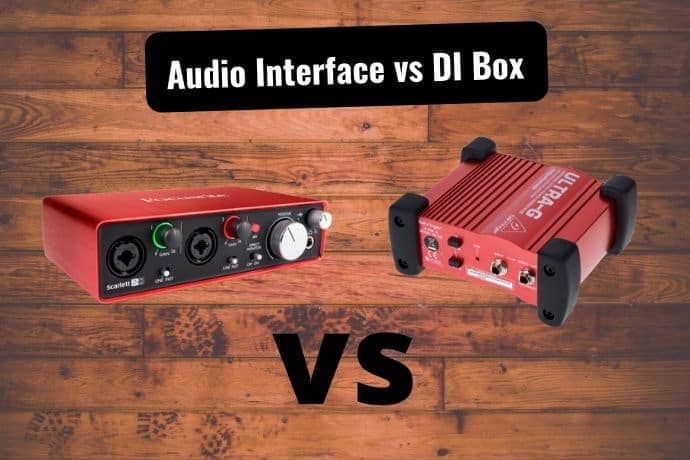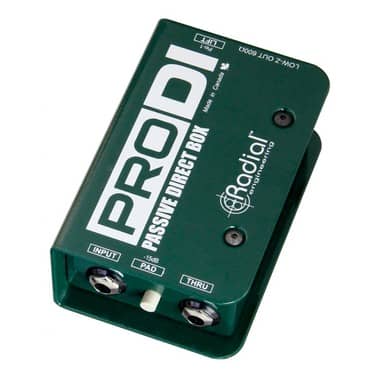
Are you interested in recording your instruments but not sure what device to choose?
The most common hardware for home studios is typically an audio interface and DI Box.
But what exactly is the difference between both devices when it comes to function, uses, and price?
What You Will Learn
Myself being an avid home recorder, this post will compare and separate both types of hardware for your convenience.
Ultimately, it will help you decide whether you need an audio interface or DI box for your home recording needs. Let’s dive in…
Both devices capture an instrument signal and convert it to a digital signal. However, an audio interface transfers a signal to a computer for audio manipulation. Whereas, A DI box takes a signal to a mixing desk for studio recording or live use. A DI box also converts a signal to a low impedance source.
Comparison Video
What is an Audio Interface

Audio interfaces are essentially external soundcards that connect to PC via USB.
They serve to capture the signal of your instrument and convert it to a digital signal for manipulation on any DAW (Digital Audio Workstation.)
Audio interfaces allow you to record the signal of your instrument directly so you can add effects, plugins, and record multiple tracks at the same time, along with virtual effects.
On the other hand, you can record an external sound using a microphone. For example, you would utilize this to record a guitar amp, acoustic guitar, or vocals depending on your preferences.
An audio interface function is to capture a high-quality signal in real-time and provide little to no latency. Furthermore, they also handle the digital to analog conversion at their output.
If you are in the market for a device, the Focusrite Scarlett 2i2 3rd Gen (Reverb.com) is regarded by the home recording community as the best affordable audio interface for recording.
This device won the reward for the best selling audio interface hence why it’s regarded as the “industry standard.”
Features
- USB connection for connectivity to PC/Laptop
- Inputs for instrument or microphone
- Gain knob – to manipulate signal input level
- Signal Indicator to warn if the input level is too high (clipping)
- Headphones input for direct silent recording
- Monitor control
- Instrument and line switch – for instruments or microphone
- PAD button – lowers the gain sensitivity ideal for high output guitar pickups
Uses
- To record a single instrument input or multiple instruments at once.
- Convert an instrument signal to a digital one for any DAW on your computer
- Record guitars direct
- Record an external sound source using a microphone
- Create simple and high-quality recordings of your instruments in real-time
Best For
- Users who want to record their instruments on a DAW for further audio manipulation
- People new to home recording as they are simple to set up and begin recording in no time
- Users with little recording knowledge who want to get started with home recording
- Medium to advanced users with a professional studio set-up
Price
Entry-level audio interfaces can cost $100 – $500 depending on the brand and the number of inputs.
USB 3.0 audio interfaces start at around $500 + which are ideal for the professional studio user.
When it comes to sound, there is little to no difference in recording quality between an audio interface and DI box although some people would disagree.
Both devices capture clear audio and little difference when comparing tonal quality although devices can vary depending on the brand and price range.
What is a DI Box

A DI box is like a Swiss army knife in the studio or for live use, this reason I give them this term is that they are extremely versatile.
To recap, an audio interface is solely used for DI’ing your signal to a computer for a DAW.
Whereas, a DI box can be utilized for multiple uses in the studio or live use. It is to be noted, a DI box is for people experienced and familiar with recording and input connectivity.
The main use of a DI box is to help solve impedance discrepancy between a signal source and different studio electronics.
In most of the cases, it’s used for electric instruments that go directly into a mixing board. It’s also for going straight into an audio interface or a mixer with guitar pedals.
DI boxes take the high impedance unbalanced output signal from an electric instrument and adjust it for low impedance balanced inputs of mixing boards and other devices.
They are usually small devices and some guitar pedals or preamps can also have an integrated DI box as a direct output for mixers.
Do You Need a DI Box? (Video Below)
You can find a DI box in almost any studio today. It’s mostly used by guitar and bass guitar players who record with their pedals straight into the mixing board
Uses
- Go from your amp direct out to a mixing console for further control over your live sound
- Re-amping your guitars
- Splitting signals
- Record a live performance without noise bleed
- DI box converts an unbalanced signal into a balanced one
- It’s mostly used by guitar and bass players who plug record their amp directly into a mixing board
- They’re usually simple and inexpensive
- Are used for home recording
Best For
- Players who want to connect their instruments into a mixing console for live or recording use
- The more advance users who have experience recording and playing live
- Beginners who happen to have a small mixing device or audio interface to record to PC
- People who play live and want an isolated recording of their instrument
Price: DI boxes are relatively inexpensive. They cost from anywhere between $20 to $200 depending on the model and brand.
Audio Interface vs DI Box Recording Quality Test
Active vs Passive DI Boxes
DI boxes can be active or passive. Although their purpose is essentially the same, there are some different uses and applications, depending on the type of instrument.
Active
Active DI boxes come with an integrated preamp. This kind of device does additional boosting, which is especially useful for some lower output instruments, like guitars with single-coil pickups.
Since they have an internal preamp, active DI boxes require some kind of a power source. This can either be via an adapter or via batteries. Some models even work with a mixer’s phantom power.
In addition, active DI boxes are a great solution if you have extremely long cables in your setup.
Since they have more headroom, active DI boxes also work great for keyboards or any guitars that have active electronics.
In these cases, you’ll be able to balance out the signal more easily with an active DI compared to a passive one. However, they are usually more expensive than passive DIs.
Passive
Although active ones are more complex, passive DI boxes are more widespread. These are the original DI boxes and they come a long way, back to the 1960s.
As the name suggests, passive DIs do not require any kind of internal or external power. They alter and pass the signal using their circuit and its components.
However, they do not include an integrated preamp. This means that passive DI boxes don’t boost the signal, but rather just accommodate it and take care of its impedance to work better with balanced inputs of mixers, preamps, or audio interfaces.
Although this seems like a fairly simple device, there are some noticeable differences between cheaper and more expensive ones.
If we were to look into a budget DI box, it wouldn’t really handle electrical hums. Whereas active DIs would manage to keep things under control.
They are less versatile compared to active DI boxes but are a cheaper and far better solution for those who don’t need to boost their initial signal. They are often used by guitar players that prefer regular passive pickups.
Do You Need a DI box with an Audio Interface
In most of the cases these days, electric guitars can go directly into audio interfaces. Such devices have specialized inputs that deal with electric instruments’ outputs.
It’s like having an integrated DI box in an audio interface. In a lot of the cases these days, guitar players use either digital amp modeling units or amp modeling software within DAWs.
Instead of relying on elaborate rigs, they use their digital replicas, including emulations of cabinets, which makes use of DI boxes pretty much obsolete.
However, those who prefer to use their rigs and pedals will need a DI box if they’re going into audio interfaces. This is especially the case if they’re using standard pedalboards.
In such settings, the signal can be too “hot” for an audio interface, resulting in a lot of clipping. A simple DI would do the trick. Active DIs here can also be useful if you need a further boost of the signal or more headroom.
If you prefer recording guitar amps with microphones, there’s no need for a device like a DI box.
Audio interfaces are designed to work with both dynamic and condenser mics, and you’ll be getting that realistic tone without any additional signal-altering devices.
Related Questions
Does a DI box boost signal?
It depends. Only active DI boxes boost the signal, passive ones don’t. This is useful for any instrument that has a really quiet output, like a guitar with single-coil pickups.
Does a DI box reduce noise?
In some cases, they can get rid of all the unnecessary noise and clipping. When recording with a distortion pedal directly into a sound card, the tone can get too “sharp” or “messy.” Some advanced DI boxes can also deal with hums caused by ground loops and electrical interference.
Does an audio interface reduce CPU load?
Audio interfaces do not reduce CPU load. Low buffer size and latency will cause more CPU usage, so it’s important to find the perfect balance. Processor usage can also get high with more tracks and VST plugins.
Does it matter what audio interface I use?
In most cases, audio interfaces are specialized for certain uses or instruments. For home recording purposes, audio interfaces will have both microphone and instrument inputs. It is also important to know how many channels do you need, as audio interfaces usually have from one and up to eight channels.
